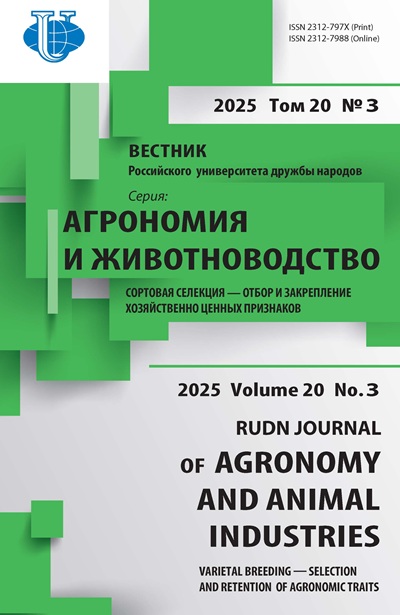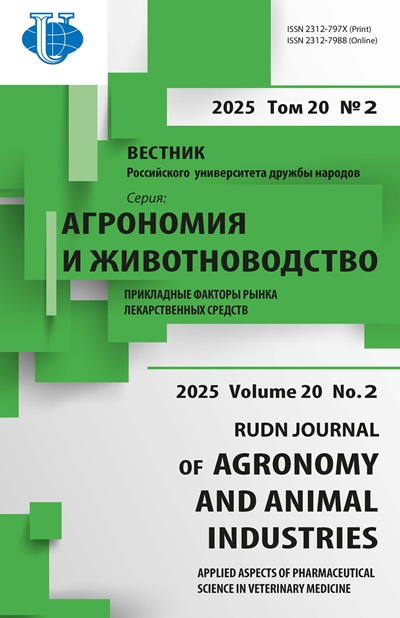Study of optimal method of Heterodera glycines sample preparation for molecular diagnostics
- Authors: Ivanov A.V.1, Bondarenko G.N.1
-
Affiliations:
- All-Russian Plant Quarantine Center
- Issue: Vol 20, No 2 (2025): Applied aspects of pharmaceutical science in veterinary medicine
- Pages: 274-286
- Section: Plant protection
- URL: https://agrojournal.rudn.ru/agronomy/article/view/20200
- DOI: https://doi.org/10.22363/2312-797X-2025-20-2-274-286
- EDN: https://elibrary.ru/NUKWDH
- ID: 20200
Cite item
Full Text
Abstract
In this study, it is optimized by the methods of preparing samples for the release of genetic material (DNA) from soybean cyst-forming nematode Heterodera glycines , which is necessary for accurate identification. Various modifications of ready-made reagent kits from Russian and foreign manufacturers were tested: DNA-Extrane-2, FitoSorb, TsytoSorb, ORB-GMO-A by Sintol LLC (Russia), Proba-GS, Proba-NK by AgroDiagnostika LLC, and QIAamp DNA Mini Kit by Qiagen (Germany). By testing the PCR method «In real time», the sensitivity of Heterodera glycines total DNA release was tested using a test system consisting of forward and reverse primers and a modified probe: SCNrtF (5’-AAATTCCAGGCCGCTATCTC-3’), SCNrtR (5’CGTGGACTGAACTGAACTGGACAAAG-3’), SCNrtP (5’-FAM/-TGGGCTGGGTGCTTCTAGAACTTTT-/ BHQ-1/-3’).
Full Text
Table 1
Amplification conditions and the composition of the reaction mixture
Stage | Temperature, 0C | Time | Cycles |
Initial denaturation | 95 | 2 min | 1 |
Denaturation | 95 | 10 secs | 50 |
Anneal primers (with fluorescence detection in the FAM channel) | 62 | 45 secs | |
| |||
The composition of the reaction mixture | Volume of component per sample, μl | ||
5Х qPCRmix-HS Evrogen | 5 | ||
Forward primer SCNrtF (10 ρmol/μl) | 1 | ||
Reverse primer SCNrtR (10 ρmol/μl) | 1 | ||
Probe SCNrtP (5 ρmol/μl) | 1 | ||
Sterile dH2O | 16 | ||
DNA sample | 1 | ||
Source: compiled by A.V. Ivanov.
Table 2
Determining the concentration of DNA isolated from Heterodera glycines
№ п/п | Reagent kit | Sample | Concentration, μg/mL | The ratio of the 260/280 nm |
1 | DNA-Extran‑2 (Sintol) | H. glycines (1) | 6.5 | 1.94 |
2 | H. glycines (2) | 3.1 | 1.88 | |
3 | H. glycines (3) | 3.7 | 1.91 | |
4 | H. glycines (4) | 5.6 | 1.87 | |
5 | H. glycines (5) | 3.5 | 1.81 | |
6 | Sorb-GMO-A (Sintol) | H. glycines (6) | 2.5 | 1.59 |
7 | H. glycines (7) | 2.8 | 1.48 | |
8 | H. glycines (8) | 2.4 | 1.49 | |
9 | H. glycines (9) | 3.5 | 1.38 | |
10 | H. glycines (10) | 1.6 | 1.59 | |
11 | Proba-GS (Agrodiagnostika) | H. glycines (11) | 11.1 | 6.26 |
12 | H. glycines (12) | 12.5 | 5.54 | |
13 | H. glycines (13) | 10.5 | 5.87 | |
14 | H. glycines (14) | 11.7 | 8.40 | |
15 | H. glycines (15) | 10.7 | 7.74 | |
16 | PhytoSorb (Sintol) | H. glycines (16) | 14.4 | 1.50 |
17 | H. glycines (17) | 18.7 | 1.44 | |
18 | H. glycines (18) | 17.4 | 1.37 | |
19 | H. glycines (19) | 20.4 | 1.40 | |
20 | H. glycines (20) | 17.5 | 1.46 | |
21 | QIAamp DNA Mini Kit (Qiagen) | H. glycines (21) | 0.7 | 0.97 |
22 | H. glycines (22) | 1.1 | 0.98 | |
23 | H. glycines (23) | 1.2 | 0.99 | |
24 | H. glycines (24) | 0.8 | 1.14 | |
25 | H. glycines (25) | 1.6 | 1.35 | |
26 | Proba-NK (Agrodiagnostika) | H. glycines (26) | 6.9 | 1.37 |
27 | H. glycines (27) | 4.9 | 1.18 | |
28 | H. glycines (28) | 9.7 | 1.44 | |
29 | H. glycines (29) | 7.0 | 1.78 | |
30 | H. glycines (30) | 5.1 | 1.31 | |
31 | CytoSorb (Sintol) | H. glycines (31) | 29.6 | 1.47 |
32 | H. glycines (32) | 29.4 | 1.50 | |
33 | H. glycines (33) | 27.1 | 1.45 | |
34 | H. glycines (34) | 27.9 | 1.45 | |
35 | H. glycines (35) | 30.6 | 1.47 |
Source: compiled by A.V. Ivanov.
Table 3
The values of the threshold cycles of PCR-RT for DNA samples isolated from H. glycines
Sample | Reagents and the threshold cycle Ct fluorescent signal FAM, specific for H. glycines SCN-SCAR marker | ||||||
DNA-Extran‑2 (Sintol) | Sorb-GMO-A (Sintol) | Proba-GS (Agro-diagnostika) | PhytoSorb (Sintol) | QIAamp DNA Mini Kit (Qiagen) | Proba-NK(Agro-diagnostika) | CytoSorb (Sintol) | |
H. glycines (1*) | 21.28 | 41.68 | 25.21 | 25.45 | 28.92 | 21.98 | 26.39 |
H. glycines (2*) | 25.05 | 30.29 | 26.09 | 25.37 | 29.61 | 23.05 | 23.24 |
H. glycines (3*) | 24.16 | 27.22 | 22.84 | 25.08 | 26.06 | 25.70 | 23.35 |
H.glycines (4*) | 21.24 | 41.56 | 23.44 | 24.70 | 27.14 | 21.81 | 27.36 |
H.glycines (5*) | 24.21 | 28.09 | 26.92 | 23.99 | 26.99 | 25.35 | 25.39 |
К- | N/A | N/A | N/A | N/A | N/A | N/A | N/A |
Av.v. ± St.er. | 23.19 ± 0.8 | 33.79 ± 3.2 | 24.90 ± 0.7 | 24.92 ± 0.3 | 27.74 ± 0.6 | 23.58 ± 0.8 | 25.15 ± 0.8 |
Note. К- — negative control sample; N/A — no fluorescence signal; Av. v. — average value; St. er. — standard error.
Source: compiled by A.V. Ivanov.
About the authors
Anton V. Ivanov
All-Russian Plant Quarantine Center
Author for correspondence.
Email: tonijons8@mail.ru
ORCID iD: 0009-0002-5361-6100
SPIN-code: 4537-6755
Junior researcher, Helminthology Laboratory, Testing Laboratory
32 Pogranichnaya st., Bykovo, 140150, Moscow region, Russian FederationGalina N. Bondarenko
All-Russian Plant Quarantine Center
Email: reseachergm@mail.ru
ORCID iD: 0000-0002-1635-2508
SPIN-code: 2631-5209
Candidate of Biological Sciences, Senior researcher, Head of the Testing Laboratory Center
32 Pogranichnaya st., Bykovo, 140150, Moscow region, Russian FederationReferences
- Ivanov AV, Sudarikova SV, Khudyakova EA. Optimized approach for the detection of Heterodera spp. and the quarantine species Heterodera glycines. Plant Health and Quarantine. 2020;(4):30–39. (In Russ.). doi: 10.69536/FKR.2020.96.92.001 EDN: JCTKEC
- Ichinohe M. On the soy bean nematode, Heterodera glycines n. sp. from Japan. Oyo-Dobutsugaku-Zasshi (Magazine of Applied Zoology). 1952;17(1/2):4.
- Cook R, Noel GR. Cyst nematodes: Globodera and Heterodera species. In: Starr JL, Cook R, Bridge J. (eds.) Plant resistance to parasitic nematodes. CABI Publishing; 2002. p.71–105. doi: 10.1079/9780851994666.0071
- Subbotin SA, Mundo-Ocampo M, Baldwin JG. Systematics of Cyst Nematodes (Nematoda: Heteroderinae). Nematodology Monographs and Perspectives. Vol. 8B. Leiden, The Netherlands: Brill; 2010.
- Subbotin SA, Peng D, Moens M. A rapid method for the identification of the soybean cyst nematode Heterodera glycines using duplex PCR. Nematology. 2001;3(4):365–371. doi: 10.1163/156854101317020286 EDN: LYYMML
- Amiri S, Subbotin SA, Moens M. Identification of the beet cyst nematode Heterodera schachtii by PCR. European Journal of Plant Pathology. 2002;108:497–506. doi: 10.1023/A:1019974101225 EDN: MAOKJT
- Madani M, Subbotin SA, Moens M. Quantitative detection of the potato cyst nematode, Globodera pallida, and the beet cyst nematode, Heterodera schachtii, using Real-Time PCR with SYBR green I dye. Molecular and Cellular Probes. 2005;19(2):81–86. doi: 10.1016/j.mcp.2004.09.006 EDN: LJAWOX
- Bekal S, Gauthier JP, Rivoal R. Genetic diversity among a complex of cereal cyst nematodes inferred from RFLP analysis of the ribosomal internal transcribed spacer region. Genome. 1997;40(4):479–486. doi: 10.1139/g97-064 EDN: LMLCPX
- Szalanski AL, Sui DD, Harris TS, Powers TO. Identification of cyst nematodes of agronomic and regulatory concern with PCR-RFLP of ITS1. Journal of Nematology. 1997;29(3):255–267.
- Subbotin SA, Waeyenberge L, Moens M. Identification of cyst forming nematodes of the genus Heterodera (Nematoda: Heteroderidae) based on the ribosomal DNA-RFLPs. Nematology. 2000;2(2):153–164. doi: 10.1163/156854100509042 EDN: LGBXHV
- Zheng J, Subbotin SA, Waeyenberge L, Moens M. Molecular characterisation of Chinese Heterodera glycines and H. avenae populations based on RFLPs and sequences of rDNA-ITS regions. Russian Journal of Nematology. 2000;8(2):109–113. EDN: LGBQPF
- Ou S, Peng D, Liu X, Li Y, Moens M. Identification of Heterodera glycines using PCR with sequence characterized amplified region (SCAR) primers. Nematology. 2008;10(3):397–403. doi: 10.1163/156854108783900212 EDN: LYYMRB
- Ye W. Development of PrimeTime-Real-Time PCR for Species Identification of Soybean Cyst Nematode (Heterodera glycines Ichinohe,1952) in North Carolina. Russian Journal of Nematology. 2012;44(3):284–290.
- Rebrikov DV, Samatov GA, Trofimov DY, Semenov PA, Savilova AM, Kofiadi IA, et al. PTsR v real’nom vremeni [Real-time PCR]. Moscow: BINOM publ.; 2009. (In Russ.).
Supplementary files















